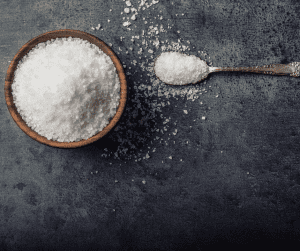Can salt be enjoyed freely or should you exercise caution? Read on to find out more.

Salty snacks, tasty cheese with olives, or smoked ham on bread: The salt content in these savoury treats plays a decisive role in our perception of flavour. Salt is essential for the human body. The amount of table salt we consume is rising and this is now coming under increasing criticism. From the origins of salt, to salt intake, high-salt food and alternative seasoning methods. Find out more here!
What is salt and how is it produced?
Table salt, also known as common salt, is composed of the minerals sodium and chloride. In the past, salt was used as a valuable trading commodity because of its preservative effect on food thanks to its chemical structure. Salt binds water and thus removes it from the food. For example, salt was used to preserve fish during long boat voyages. Salt also plays a crucial role in the fermentation of vegetables. In this process, salt prevents microorganisms which would otherwise spoil the product from accumulating in the fermented food. This stops the formation of mould and growth of bacteria.
These days, salt production is more standardised and China and the USA are the world’s two largest producers. Germany is in fourth place.
But where does salt come from?
Salt is occurs naturally. Bodies of water such as lakes, brine springs or the sea are rich sources. Salt is also mined from rocks such as on mountains or in salt mines. The famous Fleur de Sel is scooped up manually from a basin of seawater, where salt crystals have formed on the surface. Conventional table salts are processed after mechanical mining. An anti-caking agent is often added to prevent salt crystals forming clumps in the salt cellar. In the supermarket you can often find table salt that has been enriched with iodine and/or fluorine. The aim of this is to prevent deficiencies of these minerals in the population.
What role does table salt play in the human body?
The human body is 0.9% salt. The minerals contained in table salt are essential for various metabolic processes. As electrolytes, they help to regulate the fluid and acid-base balance. Sodium also promotes the absorption and transport of nutrients.
Do you sometimes have a strong craving for salty foods? It was originally assumed that this craving for salt was the body’s natural way of expressing that it needed sodium chloride. However, in addition to individual needs, diet and habit seem to have a greater influence on salt cravings these days. Thus, a high daily salt intake can also lead to consistent cravings for more salt. The assumption is that consuming salt has mood-enhancing effects. But the exact way this mechanism works remains unclear.
What are the current intake recommendations?
The human body naturally excretes 3–20 g of salt per day, depending on physical activity. Therefore a daily intake of table salt is necessary to maintain bodily functions. The minimum requirement of sodium chloride is approximately 1.5 g per day. The German Nutrition Society (DGE) currently recommends a maximum intake of six grams of salt per day.
This is because excessive salt can have adverse health effects. In salt-sensitive people, too much salt results in raised blood pressure. High blood pressure can lead to the development of cardiovascular diseases. The effect of too much salt on blood pressure varies from person to person. In people who are salt-resistant, an increased intake results in little or no increase in blood pressure. Despite this, excessive consumption should be avoided as much as possible to prevent high blood pressure.
Which foods contain the most salt?
Salt is most prevalent in processed foods. In addition to convenience foods, cured meats, cheeses and baked goods also contain a lot of salt. The addition of salt to cooking water or to food directly forms a lesser part of total intake.
If you would like to start taking a closer look at your daily salt intake from processed foods, then take a look at the nutrition information label – this will tell you how much salt the food contains. You may only be able to find the amount of sodium on your food’s nutrition facts label. But how can the salt content in food be calculated from the sodium value provided? Multiply the sodium content by a factor of 2.54 – this results in the total amount of table salt in the food.
What alternative seasoning methods are there?
For the food groups mentioned above, you have the option of choosing an alternative that contains less salt. For sausages, try turkey cold cuts instead of smoked ham. High-salt cheeses include Parmesan, Roquefort and also processed cheeses. Cream cheese or, for a slightly fuller flavour Camembert, is a good way of consuming less salt. It is also worth taking a look at the salt content of snacks. Cheese crackers or sesame sticks are a good alternative to pretzel sticks. For nuts, you can simply opt for the unsalted variety.
Using fresh herbs when cooking is another tasty option. The sky’s the limit when it comes to adding herbs! Your meals will be transformed into new culinary creations with a wide range of flavours. Why not try adding lemon thyme or marjoram to your tomato sauce when you cook pasta? Perhaps this alternative method of adding flavour will even encourage you to reach for the salt less often!
To keep herbs fresh for as long as possible, cut their ends with a knife after purchasing and place the bundles in a glass of water. It is best to store the herb bouquet in your Liebherr Fridge so the herbs stay fresh and flavourful for a long time. Herbs that you don’t need at the moment can also be easily frozen. To do this, simply fill an ice cube tray with freshly chopped herbs. That way, you’ll always have a stock of herb cubes.